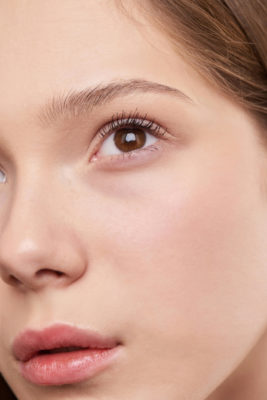
Why You Should Be Paying Attention To Your Oral Microbiome
By
10 months ago
Oral health sits next to gut health
According to professionals, your mouth is just as important as your gut when it comes to microbial health – but how should we go about keeping it in tip-top shape? Here’s everything you need to know about the oral microbiome.
What Is The Oral Microbiome?
‘The oral microbiome is a diverse collection of microorganisms that live in the human mouth,’ explains Dr Tom Crawford-Clarke, a cosmetic dentist and the founder of LUCEO Dental. ‘It plays a crucial role in digestion, production of vitamins and maintaining the health of oral tissues. It also helps in regulating the immune response and protecting against pathogenic microbes.’
@drmilesmadison Replying to @stros56 This is why mouthwashes with alcohol are bad for your oral microbiome! #listerine #hack #dentist #education #mouthwash #gumsurgeon #teeth ♬ Flowers – Miley Cyrus
What Does A Healthy Oral Microbiome Look & Feel Like?
To better check for it, Dr Crawford-Clarke says we first need to understand what constitutes a healthy oral microbiome. ‘A healthy oral microbiome is characterised by a balanced and diverse community of microorganisms that coexist without causing disease,’ he says. ‘No single species dominates the community excessively, preventing overgrowth of harmful pathogens.
‘We want to see an absence of bad breath (by this we mean persistent bad breath, known as halitosis), which indicates a balanced microbial environment,’ he continues. ‘We also like to hear you haven’t got a persistent bad or metallic taste in your mouth, which can be indicative of microbial imbalance. Gums should appear pink and firm without signs of inflammation, bleeding, or recession. Minimal plaque buildup and absence of tartar, would indicate that beneficial bacteria are effectively controlling harmful species. We also, unsurprisingly, like to see a low incidence of dental caries (cavities) as beneficial bacteria help neutralise acids and prevent tooth decay. And, finally, an absence of pain, ulcers, or sores in the mouth also indicate a healthy microbiome is in action.’
The Signs Of An Unhealthy Oral Microbiome
With the above in mind, it should be pretty easy to spot an unhealthy microbiome. ‘An unhealthy oral microbiome, often referred to as oral dysbiosis, is characterised by an imbalance in the microbial community, where harmful microorganisms outnumber the beneficial ones,’ explains Dr Crawford-Clarke. ‘This imbalance can lead to various oral health issues and contribute to systemic health due to a dominance of pathogenic (bad) bacteria such as streptococcus mutans, porphyromonas gingivalis, and fusobacterium nucleatum, which can cause dental diseases.
‘These harmful bacteria lead to an immune response due to their activity:
- Persistent halitosis (bad breath), often due to volatile sulphur compounds produced by harmful bacteria. Metallic taste in the mouth due to bacterial byproducts.
- Gum problems including red, swollen, and bleeding gums (gingivitis) which can then lead to gum disease (periodontitis).
- Increased incidence of cavities and dental caries due to acid-producing bacteria that demineralise tooth enamel due to lowering the oral pH.
- Excessive plaque buildup that hardens into tartar, providing a habitat for harmful bacteria.
- Reduced saliva flow (xerostomia) can disrupt the balance of the oral microbiome, leading to discomfort and increased risk of infection.’
Common Disruptors
But what causes these imbalances in the first place? ‘The most obvious cause that gets in the way of a healthy oral microbiome is poor oral hygiene – infrequent brushing, not using interdental cleaning techniques and the overuse of mouthwash,’ says Dr Crawford-Clarke. ‘Certain foods can negatively impact the balance of the oral microbiome, promoting the growth of harmful bacteria:
- Sugary foods and drinks: Harmful bacteria like Streptococcus mutans thrive on sugars, producing acids that demineralise tooth enamel and lead to cavities.
- Acidic foods and drinks: Citrus Fruits, Vinegar-Based Foods, Carbonated drinks all lower the oral pH due to their acidity making it easier for acid producing bacteria to flourish.
- Starchy foods contribute to plaque buildup, creating a biofilm that harbours harmful bacteria.
- Alcoholic beverages are themselves acidic and sugary and can also reduce saliva production, which is essential for neutralising acids and washing away food particles and bacteria.
- Ultra processed foods (UPFs) which usually contain a higher concentration of sugar and starch.
- Certain medications which can reduce saliva flow or alter the oral environment.
- Conditions such as diabetes can affect oral health and microbiome balance.
- Chronic stress can impact immune function and oral health.’
@joycethedentist The way everyone knows to brush twice a day but not the reasoning behind it. Heres the real reason. The more you know, the more you can take back control of your health. 💪 #oralmicrobiome #bacteria #healthymouth #guthealth #greenscreen ♬ original sound – Joycethedentist
The Impact Of Smoking
And, of course, there’s also the harmful effects of smoking, which Dr Crawford-Clarke says can exacerbate the signs of an unhealthy oral microbiome. ‘Smoking changes the oxygen levels in the mouth, creating an environment that favours the growth of anaerobic bacteria, which are often more harmful and associated with gum disease,’ he tells us. ‘It also causes inflammation in the gums and other oral tissues, creating conditions that support the growth of harmful bacteria and contribute to periodontal disease, as well as a decreased saliva flow, leading to reduced neutralisation of acids and increases harmful bacteria growth.
‘The chemicals in tobacco smoke also weaken the immune response in the oral tissues, making it harder for the body to fight off infections and allowing pathogenic bacteria to proliferate,’ he adds.
Does The Oral Microbiome Impact The Gut Microbiome?
If the term ‘microbiome’ sounds familiar, it’s likely because you’ve heard it in the context of your gut and skin – which, it turns out, are all actually connected. ‘The oral and gut microbiomes are interconnected parts of the body’s overall microbiome, and they impact each other through various mechanisms,’ explains Dr Crawford-Clarke. ‘Saliva contains microorganisms from the oral cavity that are continuously swallowed and enter the gastrointestinal tract, potentially influencing the gut microbiome. The journey of food and microbes from the mouth through the digestive system also allows for interactions between oral and gut microorganisms.
‘Certain bacterial species can be found in both the oral cavity and the gut,’ he continues. ‘These shared species can contribute to maintaining microbial balance and immune function across both environments. The immune system of the mucosal surfaces in the mouth and gut work cohesively to monitor and respond to microbial populations. Dysbiosis in one location can trigger immune responses that affect the other. For example, inflammatory conditions in the mouth like periodontitis have been linked to an increased risk of systemic conditions, including gut disorders. Bacteria from periodontal infections can enter the bloodstream and affect gut health. Furthermore, conditions like diabetes, obesity, and cardiovascular diseases have all been associated with dysbiosis in both the oral and gut microbiomes, suggesting a bidirectional influence.’
Does It Differ Between Men & Women?
You’ll also find differences between men and women when it comes to their oral microbiomes. ‘These differences can be influenced by various factors, including hormonal variations (oestrogen, progesterone and testosterone), dietary habits and lifestyle choices,’ highlights Dr Crawford-Clarke. ‘Research has shown that certain bacterial species may be more prevalent in one sex compared to the other. For example, men are generally more prone to periodontal disease, which could be linked to differences in the oral microbiome and related immune responses.’
How To Improve Your Oral Microbiome
If things aren’t looking too good in your mouth right now, don’t worry – there are ways to bring the oral microbiome back to a healthy level. ‘Improving your oral microbiome involves adopting practices that promote the growth of beneficial bacteria and reduce harmful bacteria,’ says Dr Crawford-Clarke. ‘These include:
- Good oral hygiene: Brush your teeth at least twice a day using fluoride toothpaste. Interdental cleaning to remove debris and plaque from between teeth where a toothbrush cannot reach (a toothbrush alone only cleans 60 to 70 percent of your tooth surface). Clean your tongue regularly using a tongue scraper or brush to remove bacteria and debris.
- Change in diet: It’s recommended you reduce your sugar intake, increase your fibre intake, consume probiotic foods and drink plenty of water to maintain saliva production. Chewing sugar free, xylitol containing chewing gum after meals stimulates salvia production and reduces harmful bacteria.
- Avoid harmful substances: Avoid tobacco smoking and limit alcohol consumption.
- Visit your dentist: Routine dental examinations and professional hygienist cleaning ideally with the gold standard air polish treatment.
- Stress relief: Reduce stress through activities like exercise, meditation, and proper sleep, as stress can impact immune function and oral health.’
Featured image: Cesar La Rosa, Unsplash









